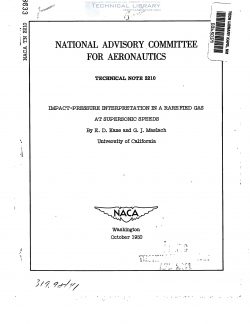naca-tn-2210
- Version
- 46 Downloads
- 1.48 MB File Size
- 1 File Count
- December 14, 2016 Create Date
- December 14, 2016 Last Updated
National Advisory Committee for Aeronautics, Technical Notes - Impact Pressure Interpretation in a Rarefied Gas at Supersonic Speeds

The interpretation of measured impact pressures in a rarefied gas
is reviewed and available analyses are summarized. Experimental results
are presented for source-shaped impact tubes for Mach numbers between 2.3
and 3.6 and Reynolds numbers from 25 to 80h. The data show that the
Rayleigh formula requires correction for conditions where the ratio of
mach number to Reynolds number is greater than 0.015, where the Reynolds
number is based on the impact—probe diameter and free—stream conditions.
The maximum correction to the Rayleigh formula, obtained at the low
pressure limit of the experimental equipment, was 13 percent (when the
ratio of Mach number to Reynolds number was 0.093).
One of the basic instrumentation techniques in aerodynamics involves
insertion of a probe into the flow field and measurement of a pressure
at an orifice or tap located at the probe surface. By means of an appro-
priate analysis for a given probe shape, or by direct calibration, the
measured pressure can be related to certain properties of the gas flow.
A common example of this procedure is the use of an impact or total-head
tube which gives a pressure that is related to the Mach number and static
pressure (reference 1, p. 77), or two equivalent quantities, by an analy-
sis based on the assumption of a nonviscous, compressible fluid.
This analysis fails when the viscous forces become appreciable compared with
the inertia or pressure forces in the fluid; that is, when the Reynolds
number becomes sufficiently small. The behavior of an impact tube in a
viscous, incompressible fluid at low speeds was examined by Homann (ref-
erence 2). Recently, the analysis was extended to include compressiblity
effects (reference 3), with the result that a measured impact pressure
was found to be related to a Reynolds number in addition to the mach
number and static pressure. The conclusions of reference 3 were verified
approximately by experimental work performed at subsonic speeds (refer-
ence h). For a sufficiently rarefied gas, where continuum treatments
fail but the methods of kinetic theory are applicable, an analytical solu-
tion relating an impact pressure to free-stream conditions efists (ref-
erence 5) and has been verified partially in a molecular—beam apparatus
(reference 6). No results have been available in the transition region
between continuum and extremely rarefied (free-molecular) flow conditions.
| File | Action |
|---|---|
| naca-tn-2210 Impact Pressure Interpretation in a Rarefied Gas at Supersonic Speeds.pdf | Download |
Comment On This Post